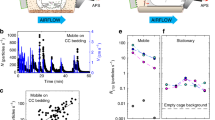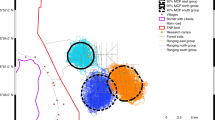Abstract
Studying the transmission of simian retroviruses to humans can help define the importance of these infections to public health. We identified a substantial prevalence (4/231, 1.8%) of infection with simian foamy viruses (SFV) among humans occupationally exposed to nonhuman primates. Evidence of SFV infection included seropositivity, proviral DNA detection and isolation of foamy virus. The infecting SFV originated from an African green monkey (one person) and baboons (three people). These infections have not as yet resulted in either disease or sexual transmission, and may represent benign end point infections.
This is a preview of subscription content, access via your institution
Access options
Subscribe to this journal
Receive 12 print issues and online access
$209.00 per year
only $17.42 per issue
Buy this article
- Purchase on Springer Link
- Instant access to full article PDF
Prices may be subject to local taxes which are calculated during checkout
Similar content being viewed by others
References
Gessain, A., Gallo, R.C. & Franchini, G. Low degree of human T cell leukemia/lym-phoma virus type I genetic drift in vivo as a means of monitoring viral transmission and movement of ancient human populations. J. Virol. 66, 2288–2295 (1992).
Switzer, W.M. et al. Phylogenetic relationships and geographic distributions of multiple human T-cell lymphotropic virus type II subtypes. J. Virol. 69, 621–632 (1995).
Franchini, G. & Reitz, M.S. Phylogenesis and genetic complexity of the nonhuman primate retroviridae. AIDS Res. Hum. Retrovir. 10, 1047–1060 (1994).
Myers, G., Maclnnes, K. & Korber, B. The emergence of simian/human immunodeficiency viruses. AIDS Res. Hum. Retrovir. 8, 373–386 (1992).
Hooks, J.J. & Gibbs, C. The foamy viruses. Bacteriol. Rev. 39, 169–185 (1975).
Neumann-Haefelin, D., Fleps, U., Renne, R. & Schweizer, M. Foamy viruses. Intervirology 35, 196–207 (1993).
Schweizer, M. et al. Markers of foamy virus infections in monkeys, apes, and accidentally infected humans: appropriate testing fails to confirm suspected foamy virus prevalence in humans. AIDS Res. & Hum. Retrov. 11, 161–170 (1995).
Schweizer, M. & Neumann-Haefelin, D. Phylogenetic analysis of primate foamy viruses by comparison of pol sequences. Virology 207, 577–582 (1995).
Bieniascz, P.D et al. A comparative study of higher primate foamy viruses, including a new virus from a gorilla. Virology 207, 217–228 (1995).
McClure, M.O. et al. Isolation of a new foamy retrovirus from Orangutans. J. Virol. 68, 7124–7130 (1994).
Herchenroder, O. et al. Isolation, cloning, and sequencing of simian foamy viruses from chimpanzees (SFVcpz): high homology to human foamy virus (HFV). Virology 201, 187–199 (1994).
Achong, B.G., Mansell, P.W.A., Epstein, M.A. & Cifford, P. An unusual virus in cultures from a human nasopharyngeal carcinoma. J. Natl. Cancer Inst. 46, 299–302 (1971).
Ali, M. et al. No evidence of antibody to human foamy virus in widespread human populations. AIDS Res. Hum. Retrovir. 12, 1473–1483 (1996).
Lerche, N.W., Yee, J.L. & Jennings, M.B. Establishing specific retrovirus-free breeding colonies of macaques: An approach to primary screening and surveillance. Lab. Animal Science 44, 217–221 (1994).
Van Brussel, M., Goubau, P., Rousseau, R., Desmyter, J. & Vandamme, A.M. The genomic structure of a new simian T-lymphotropic virus, STLV-PH969, differs from that of human T-lymphotropic virus types I and II. J. Gen. Virol. 77, 347–358 (1996).
Digilio, L. et al. The simian T-lymphotropic /leukemia virus from Pan paniscus belongs to the type 2 family and infects Asian macaques. J. Virol. 71, 3684–3692 (1997).
Schweizer, M., Falcone, V., Gange, J., Turek, R. & Neumann-Haefelin, D. Simian foamy virus isolated from an accidently infected human individual. J. Virol. 71, 4821–24 (1997).
Khabbaz, R.F. et al. Brief report: infection of a laboratory worker with simian immunodeficiency virus. New Engl. J. Med. 330, 172–177 (1994).
Murphy, F.A. The public health risk of animal organ and tissue transplantation into humans. Science 273, 7426–7427 (1996).
Patience, C., Takeuchi, Y. & Weiss, R. Infection of human cells by an endogenous retrovirus of pigs. Nature Med. 3, 282 (1997).
Starzl, T.E. et al. Baboon-to-human liver transplantation. Lancet 341, 65–71 (1993).
Rhodes-Feuillette, A., Saal, F., Lasneret, J., Dubouch, P. & Peries, J. Isolation of a new simian foamy virus serotype from lymphocytes of a Papio cynocephalus baboon. J. Med. Primatol. 8, 308–320 (1979).
Kaplan, J.E., & Khabbaz, R.F., The epidemiology of human T lymphotropic virus types I and II. Rev. Med. Virol. 3, 137–148 (1993).
Holmberg, S.D. The estimated prevalence and incidence of HIV in 96 large US metropolitan areas. Am J Public Health 86, 642–654 (1996).
Sotir, M. et al. Risk of occupational exposure to potentially infectious nonhuman primate materials and to simian immunodeficiency virus. J. Med. Primatol. 26, 233–240 (1997).
Otsyula, M. et al. Prevalence of antibodies against simian immunodeficiency virus (SIV) and simian T-lymphotropic virus (STLV) in a colony of non-human primates in Kenya, East Africa. A. Trop. Med. Parasitol. 90, 65–70 (1996).
Fultz, P.N., Gordon, T.P., Anderson, D. & McClure, H.M. Prevalence of natural infection with simian immunodeficiency virus and simian T-cell leukemia virus type I in a breeding colony of sooty mangabey monkeys. AIDS 4, 619–625 (1990).
Rudolph, D.L. et al. Serologic confirmation of simian T-lymphotropic virus type I infection by using immunoassays developed for human T-lymphotropic virus antibody detection. J. Clin. Microbiol. 30, 858–61 (1992).
Higgins, D.G. & Sharp, P.M. Clustal: a package for performing multiple sequence alignments on a microcomputer. Gene 73, 237–244 (1988).
Kumar, S., Tamura, K. & Nei, M. MEGA: Molecular evolutionary Genetics Analyses, version 1.0 (1993).Pennsylvania State University, University Park, Pa. USA.
Heneine, W., Yamamoto, S., Switzer, W.M. & Folks, T.M. Detection of reverse transcriptase by a highly sensitive assay in sera from individuals infected with the human immunodeficiency virus type 1. J. Inf. Dis. 171, 1210–1216 (1995).
Yamamoto, S., Folks, T.M. & Heneine, W. Highly sensitive qualitative and quantitative detection of reverse transcriptase activity: Optimization, validation and comparative analysis with other detection systems. J. Vim. Methods 61, 135–143(1996).
Author information
Authors and Affiliations
Rights and permissions
About this article
Cite this article
Heneine, W., Switzer, W., Sandstrom, P. et al. Identification of a human population infected with simian foamy viruses. Nat Med 4, 403–407 (1998). https://doi.org/10.1038/nm0498-403
Received:
Accepted:
Issue Date:
DOI: https://doi.org/10.1038/nm0498-403
This article is cited by
-
The origin of porcine endogenous retroviruses (PERVs)
Archives of Virology (2021)
-
Foamy virus zoonotic infections
Retrovirology (2017)
-
Wide distribution and ancient evolutionary history of simian foamy viruses in New World primates
Retrovirology (2015)
-
Discovery of prosimian and afrotherian foamy viruses and potential cross species transmissions amidst stable and ancient mammalian co-evolution
Retrovirology (2014)
-
Horizontal acquisition and a broad biodistribution typify simian foamy virus infection in a cohort of Macaca fascicularis
Virology Journal (2013)



